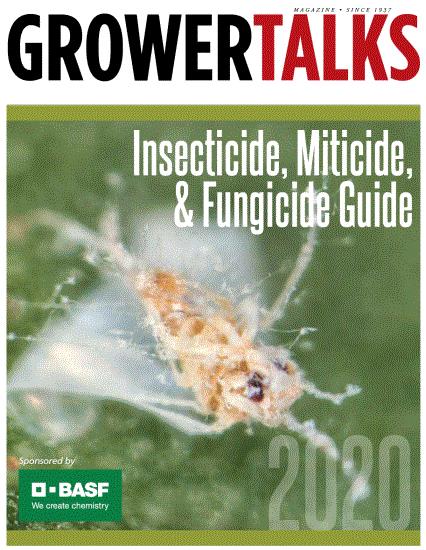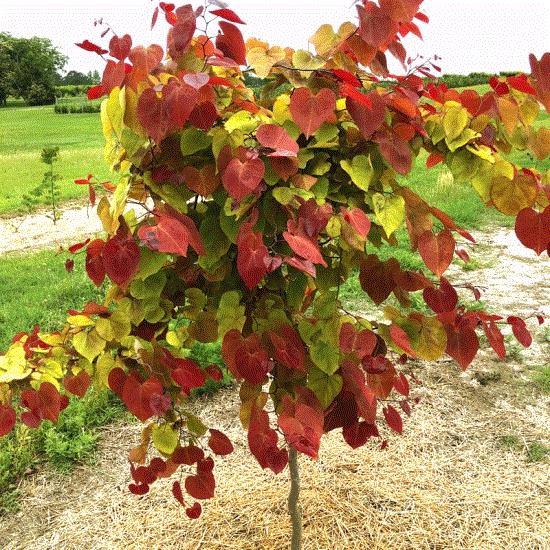GrowerTalks IMF Guide Released
Before your imagination takes you to a really sarcastic (and humorous) place, IMF stands for Insecticide, Miticide & Fungicide Guide. And this year’s version is out (can be downloaded HERE).

The IMF Guide is a comprehensive resource, sponsored by BASF, that not only includes pest-specific recommendations, but also great technical articles from folks like Dr. Raymond Cloyd (Kansas State University) and Dr. JC Chong (Clemson University and PestTalks editor). It’s certainly worth a look, if for no other reason than to see what’s new (and there are new products this year)!
Acelepryn Insecticide from Syngenta
Speaking of new products, Acelepryn insecticide from Syngenta has been approved by the U.S. EPA for use in ornamental nurseries, as well as greenhouses. Powered by the active ingredient chlorantraniliprole, Acelepryn provides long-lasting control of Japanese beetles, sawfly larvae and leaf-feeding caterpillars, including eastern tent caterpillars, fall webworm and bagworms.

With its novel mode of action, Acelepryn offers an alternative for growers looking for newer chemistries to add to their program. Additional benefits include:
-
Four-hour REI (restricted-entry interval) reduces disruptions to work schedules
-
Minimal personal protective equipment is required, compared to alternative products that require a respirator for early entry
-
No known adverse effects on beneficial and non-target organisms, such as bees and biological control agents
“The combination of strong efficacy, long residual as a foliar spray and very low impact to non-target organisms is a unique combination,” says Daniel Potter, Ph.D., professor of entomology at the University of Kentucky. “Acelepryn controls a lot of important chewing pests, giving you the flexibility of not having to apply it over and over again.”
In addition to foliar sprays, Acelepryn can be applied as a bark treatment to protect from pests like clearwing borers, as a drench to control white grubs or as a systemic soil treatment to prevent lace bugs, aphids and birch leafminers. Acelepryn is also approved for use on ornamental plants in exterior landscapes and interior plantscapes.
For more information, visit GreenCastOnline.com/AceleprynInsecticide.

Flame Thrower Redbud Wins at Farwest
Congrats to Dr. Denny Werner, breeder of Flame Thrower Redbud, and Star Roses & Plants on being awarded the 2019 People’s Choice Award at Farwest. Competition was stiff, as it always is, and this is a truly worthy cultivar developed by an excellent plant breeder and gentleman.

According to Star, this breakthrough redbud cultivar has an extremely unique foliage color, with four to five different foliage colors (burgundy, red, orange, yellow and lime) on just one branch. New growth is burgundy/red and ages to bright yellow, then green. Leaf scorch is very minimal, and the tree itself is low maintenance. It has a semi-pendulous habit, growing to 15- to 20-ft. high and 15-ft. wide. It's currently available from Star Roses & Plants as bareroot whips, according to their press release.
As with most redbud cultivars, it performs best in Zones 5 to 9. However, as with many of the newer cultivars sporting a unique foliage color, you may want to be careful putting it in full afternoon sun and/or a dry site in Zones 8 to 9, as foliage color can fade a bit in late summer when it doesn’t have decent soil moisture and some late afternoon shade.

Cape Hatteras Hydrangea
While not the big winner, Seaside Serenade Cape Hatteras Hydrangea did garner an honorable mention. This hydrangea was developed and released by Kolster BV in The Netherlands and introduced to the North American market by Farwest Show exhibitor Monrovia, which had it available for ordering at the show in #2 and #5 containers.

According to Monrovia, the deep burgundy red of this bloom is hard to believe and down in Georgia it certainly is the reddest of those I've trialed. The blooms are offset with deep-green foliage and the stems are very strong, holding up to 10-in. blooms without breakage during heavy rain. The thick stems are due to the fact it is a tetraploid (it has an extra set of chromosomes), which also causes deeply colored, leathery foliage and longer-lasting blooms.
It flowers in spring and summer in northern areas (Zones 4 to 7) with an ultimate size of 3.5-ft. tall and 3-ft. wide. In the deep south (Zones 8 to 9), it seems to, like most hydrangeas, take a breather during the hottest part of the summer and bloom heavily going into fall. It makes a statement in the garden or as an entryway accent in a container. The blooms hold their color for an extended period of time and make excellent dried flowers. The compact habit without the use of PGRs fits usefully into a variety of smaller spaces in the landscape.

RootSmart Propagation
There seem to be more and more "propagation systems" out there these days, with many focusing on the age-old (and proven by research) notion that air pruning of liner root systems will lead to less girdling (circling) root problems down the road. Recently, one such system came to my knowledge, developed by researchers at the Vineland Research & Innovation Centre up in Ontario, Canada.
Termed the RootSmart system, it was developed to improve tree growth and performance in the liner stage by reducing the development of misdirected roots (ascending, descending and circling roots). The RootSmart tray works with bounded transplantable plugs to promote air-pruning. With its wall-less and bottomless design, the tray offers a surface area 95% exposed to air while still providing the crop with adequate moisture and access to nutrients.

The design of the RootSmart propagation "tray" is unique in that it holds liner cells up, a couple of inches off the bench, to help facilitate root pruning.
At first glance, I like several aspects of this system. First, the substrate is held in a woven form, which makes sorting and bumping up easy. Second, the tray has no disposable parts—it can be reused again and again (after the surface is sterilized). Third, it appears that the design would be well suited for ebb-and-flood systems, as the cells are held off the benchtop by the legs that are taller than the cells.
Time will tell if this system is the real deal—I've requested some RootSmart trays to do a side-by-side trial with the old-fashioned method of propagating in 32- to 36-cell trays. I’ll report back when I have some results. In the meantime, if you’ve tried this system, shoot me a message and let me know what you think of it.

2020 SNA Conference Lineup Announced
If you’re looking for an event that includes some of the best plant folks in the world, you won’t be disappointed with the program that Dr. Richard Olsen and Dr. Thomas Molnar, co-chairs of the SNA Conference, have pulled together. This remarkable lineup of speakers for the 2020 SNA Conference includes 15 experts from across the U.S. who'll share their knowledge during this day-and-a-half conference.
Scheduled for Monday and Tuesday, January 6 and 7, two days before MANTS, The SNA Conference will feature a stellar cast of speakers, keynote sessions, plant conference, research conference and roundtable discussions with meaningful topics relating to economic conditions, legislative and regulatory issues impacting your business, new plants coming to market, and the latest in horticultural research.
The SNA Conference provides the perfect platform for the grower, landscaper and retailer to connect, collaborate and gain new insight. Make plans now to attend this exciting event on the Monday and Tuesday before the opening of MANTS at the Baltimore Convention Center.

NALP & IGI Promote Green Industry at FFA
This fall, NALP (National Association of Landscape Professionals) will partner with fellow industry stakeholders to create a 20-ft. by 40-ft. interactive career exploration exhibit focused on the lawn and landscape industry October 30 to November 2 at the National FFA Convention and Expo in Indianapolis, Indiana. If you’ve never been to the FFA National Convention, then you've certainly missed out on one of those events that renews your faith in the next generation of agriculture professionals!
NALP, through the Industry Growth Initiative (IGI), will lead the industry presence to showcase the landscape profession as a vibrant and smart career choice to the more than 47,000 students in attendance. NALP will help educators and students gain an understanding of various career paths (both with and without a college education), learn about available jobs and skills needed for those jobs, and direct them to the resources available on landscapeindustrycareers.org. This year, NALP will also include messaging about the new Landscape Management Apprenticeship Program.
The 2019 event sponsors include: Davey, STIHL, LandCare, FMC, Interlocking Concrete Pavement Institute, and the Irrigation Association.
Companies wishing to partner with NALP on this opportunity—focusing on promoting the industry as a whole, in addition to their own brand—should contact Jenn Myers at (443) 974-8293. If you’re looking for a golden opportunity to promote our industry, it doesn’t get better than this.

Our Wacky Wonderful World—Notes from the Edge of Sanity
In the last newsletter, I asked you wise and distinguished readers to provide your opinion on a couple of economic questions. If you remember a few weeks ago (don’t feel bad if you don’t), the news cycle was buzzing about “economic indicators” showing a weaker economy heading into 2021, with some economists throwing around the “R” word.
Well, the results were pretty interesting (to me). First, I was a bit surprised, as 291 of you responded. Heck, I didn’t know 291 people actually read the newsletter, but maybe this means they’ll keep me around for a little longer.
As to the first question, “Do you think a recession will occur on or before 2021?”, the survey said:
-
Yes (a recession will occur): 47.4% (138 respondents)
-
No (the economy will keep buzzin’ along): 52.6% (153 respondents)
As to the second question, “Do you have contingency plans in place in case of recession?”, the survey said:
-
Yes (have a plan): 68.4% (199 respondents)
-
No (don’t have a plan): 31.6% (92 respondents)
It certainly seems like we’re a positive bunch, as only 47.4% of you are predicting a recession, compared to around 75% of economists surveyed by the Washington Post back in mid-August. But wait … CBS reported only 34% of economists predicted a recession back in August.
My head hurts ... news is so confusing these days.
If there’s any good news, it's that over two-thirds of you have a plan in place to combat a recession. Now, that plan may be a case of Miller Lite and a box of Little Debbie chocolate brownies to offset the sadness, but at least you’re thinking about it! I do recommend everyone putting serious thought as to how you respond to a slowing economy, though, as it could be what saves your business. Oh—and you don’t have to own a business to consider how to respond to recession—every employee’s opinions and decisions matter!

Live authentic,

Matthew Chappell
Editor-at-Large
Nursery & Landscape Insider
This has been received by 30,890 of the hardest-working horticulturists in show business!
If you're interested in reaching 30,890 (and growing) clients who eagerly await every Nursery & Landscape Insider and surely read every word, contact Kim Brown ASAP and she'll hook you up. And thanks for helping us reach a community of 30,000+ fellow horticulturists! Keep spreading the word.